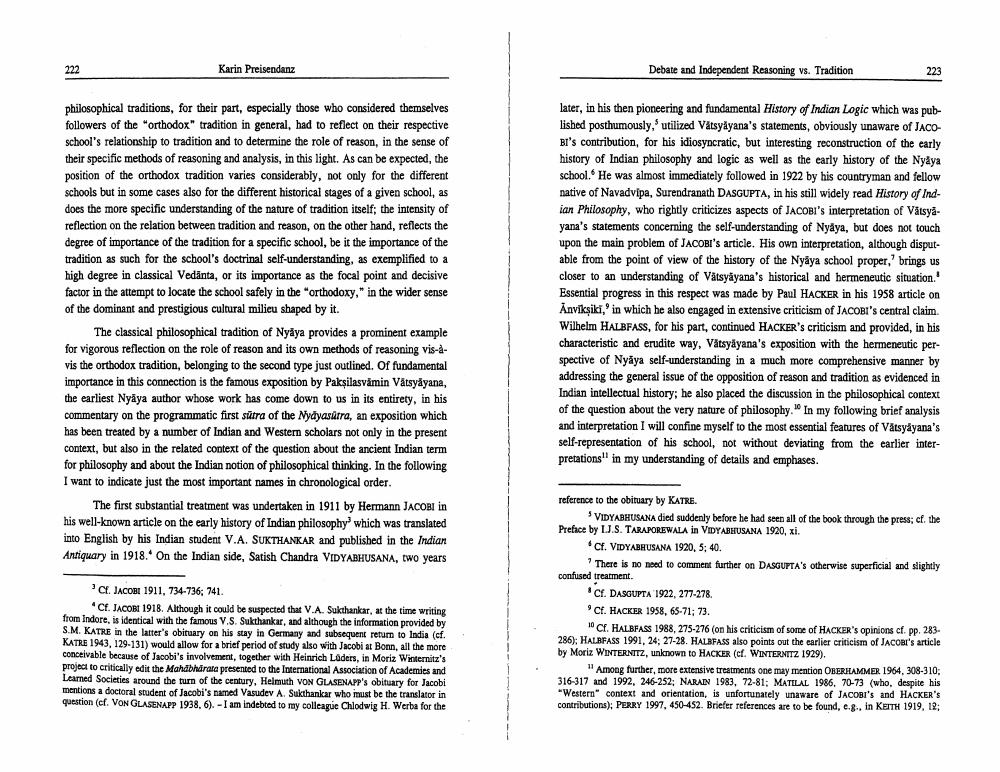________________
Karin Preisendanz
Debate and Independent Reasoning vs. Tradition
223
philosophical traditions, for their part, especially those who considered themselves followers of the orthodox" tradition in general, had to reflect on their respective school's relationship to tradition and to determine the role of reason, in the sense of their specific methods of reasoning and analysis, in this light. As can be expected, the position of the orthodox tradition varies considerably, not only for the different schools but in some cases also for the different historical stages of a given school, as does the more specific understanding of the nature of tradition itself; the intensity of reflection on the relation between tradition and reason, on the other hand, reflects the degree of importance of the tradition for a specific school, be it the importance of the tradition as such for the school's doctrinal self-understanding, as exemplified to a high degree in classical Vedānta, or its importance as the focal point and decisive factor in the attempt to locate the school safely in the orthodoxy," in the wider sense of the dominant and prestigious cultural milieu shaped by it.
The classical philosophical tradition of Nyāya provides a prominent example for vigorous reflection on the role of reason and its own methods of reasoning vis-àvis the orthodox tradition, belonging to the second type just outlined. Of fundamental importance in this connection is the famous exposition by Paksilasvamin Vatsyayana, the earliest Nyāya author whose work has come down to us in its entirety, in his commentary on the programmatic first sūtra of the Mydyasárra, an exposition which has been treated by a number of Indian and Western scholars not only in the present context, but also in the related context of the question about the ancient Indian term for philosophy and about the Indian notion of philosophical thinking. In the following I want to indicate just the most important names in chronological order.
The first substantial treatment was undertaken in 1911 by Hermann Jacob in his well-known article on the early history of Indian philosophy' which was translated into English by his Indian student V.A. SUKTHANKAR and published in the Indian Antiquary in 1918. On the Indian side, Satish Chandra VIDYABHUSANA, two years
later, in his then pioneering and fundamental History of Indian Logic which was published posthumously,' utilized Vätsyiyana's statements, obviously unaware of JACOBI's contribution, for his idiosyncratic, but interesting reconstruction of the early history of Indian philosophy and logic as well as the early history of the Nyaya school. He was almost immediately followed in 1922 by his countryman and fellow native of Navadvipa, Surendranath DASGUPTA, in his still widely read History of Indian Philosophy, who rightly criticizes aspects of JACOBI's interpretation of Vatsya. yana's statements concerning the self-understanding of Nyaya, but does not touch upon the main problem of JACOBI's article. His own interpretation, although disputable from the point of view of the history of the Nyaya school proper brings us closer to an understanding of Vätsyāyana's historical and hermeneutic situation.' Essential progress in this respect was made by Paul HACKER in his 1958 article on Anvikșiki,' in which he also engaged in extensive criticism of JACOBI's central claim. Wilhelm HALBFASS, for his part, continued HACKER's criticism and provided, in his characteristic and erudite way. Vätsyāyana's exposition with the hermeneutic perspective of Nyaya self-understanding in a much more comprehensive manner by addressing the general issue of the opposition of reason and tradition as evidenced in Indian intellectual history; he also placed the discussion in the philosophical context of the question about the very nature of philosophy. In my following brief analysis and interpretation I will confine myself to the most essential features of Vätsyayana's self-representation of his school, not without deviating from the earlier interpretations" in my understanding of details and emphases.
C. JACOBI 1911, 734-736; 741.
CF. JACOBI 1918. Although it could be suspected that V.A. Sukthankar, at the time writing from Indore, is identical with the famous V.S. Sukthankar, and although the information provided by S.M. KATRE in the latter's obituary on his stay in Germany and subsequent retum to India (cf. KATRE 1943, 129-131) would allow for a brief period of study also with Jacobi at Bonn, all the more conceivable because of Jacobi's involvement, together with Heinrich Lüders, in Moriz Winternitz's project to critically edit the Mahabharata presented to the International Association of Academies and Learned Societies around the turn of the century, Helmuth VON GLASENAPP's obituary for Jacobi mentions a doctoral student of Jacobi's named Vasudev A. Sukthankar who must be the translator in question (cf. VON GLASENAPP 1938, 6). -I am indebted to my colleague Chlodwig H. Werba for the
reference to the obituary by KATRE.
VIDYABHUSANA died suddenly before he had seen all of the book through the press; cf. the Preface by LJ.S. TARAPOREWALA in VIDYABHUSANA 1920, xi.
Cf. VIDYABRUSANA 1920. 5: 40.
? There is no need to comment further on DASGUPTA's otherwise superficial and slightly confused treatment.
* CF. DASGUPTA 1922, 277-278.
Cf. HACKER 1958, 65-71; 73.
10 CF. HALBFASS 1988, 275-276 (on his criticism of some of HACKER's opinions cf. pp. 283286); HALBFASS 1991, 24, 27-28. HALBFASS also points out the earlier criticism of Jacosi's article by Moriz WINTERNITZ, unknown to HACKER (cf. WINTERNITZ 1929).
"Among further, more extensive treatments one may mention OBERHAMMER 1964.308-310: 316-317 and 1992, 246-252; NARAIN 1983, 72-81: MATELAL 1986, 70-73 (who, despite his "Western" context and orientation, is unfortunately unaware of JACOBI's and HACKER'S contributions); PERRY 1997, 450-452. Briefer references are to be found, e.., in KEITH 1919, 12;




